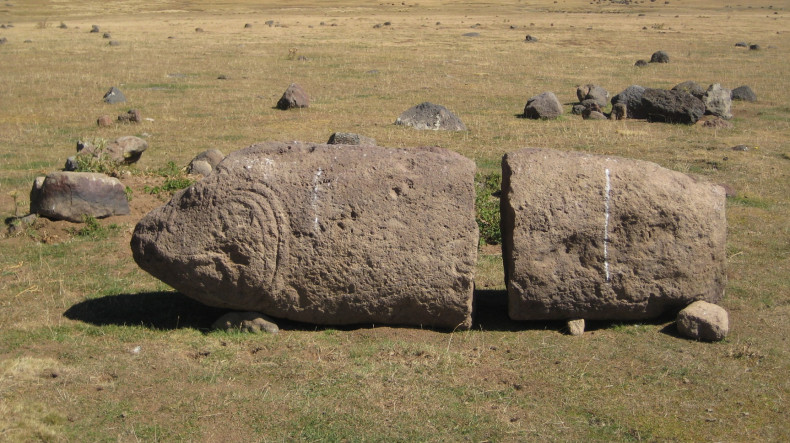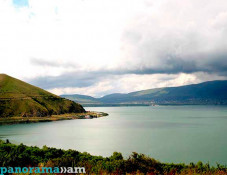
Armenia's 'dragon stones' inscribed on UNESCO World Heritage Tentative List
The Vishaps (dragon stones) and the Cultural Landscape of Tirinkatar in Armenia has been inscribed on the UNESCO World Heritage Tentative List.
Armenia's request was approved at the 46th session of UNESCO’s World Heritage Committee, the Ministry of Education, Science, Culture and Sports reported on Friday.
The Tentative List submitted by Armenia also incudes the archaeological site of the city of Dvin (1995), the basilica and archaeological site of Yererouk (1995), the monastery of Noravank and the upper Amaghou Valley (1995) and the monasteries of Tatev and Tatevi Anapat and the adjacent areas of the Vorotan Valley (1995).
In the high mountains of Armenia, unique archaeological monuments have been preserved to our days, which are traditionally called by the people “vishap” (Armenian for “dragon”). These are two to five meter high basalt stelae, which are unique among the stone stelae of the ancient world because of their unparalleled animal iconography and peculiar locations. Vishaps are either sculpted in the form of a fish (the piscis kind) or carved as if a bovine hide with head and extremities was draped over them (the vellus kind). Sometimes both iconographies are combined (the hybrida kind).
Currently ca. 150 examples of these monuments are known. As a rule, they are located in secluded, water-rich, high altitude meadows in the unforested mountains, ca. 1200-3200 m above sea level. Their highest concentration (ca. 120 examples) has been detected on Mt. Aragats, in the Geghama, Sevan, Vardenis and Syunik mountains of Armenia. The limits of their macro-regional distribution are the Lake Van region in the south, the Trialeti mountain range in the north, the Erzurum region in the west and the Sevan mountain range in the east.
The vellus vishaps are the most numerous ones and they are distributed more or less equally across the macro-region. Vishaps of the hybrida type are the rarest and they are so far confined to the south-west of the Geghama mountains in Armenia. Vishaps of the piscis kind are currently lacking in the westernmost parts of the macro-region. Since the iconography of vishaps is unique, standardized and very specific, their large-scale distribution pattern testifies to the existence of a symbolic and religious common background shared by social groups across the entire region at the time of their erection.
The most significant high altitude site with vishaps and related archaeological monuments is Tirinkatar (Armenian for “Height of the God Tir”). It is an over 370 ha vast archaeological site located on the southern slopes of Mt. Aragats, at an altitude of ca. 2700-3100 m above sea level. Also known by local pastoralist communities as “Karmir Sar” (Armenian for “Red Hill”), it is a stunning summer pasture, rich in grass and water, with spectacular views both of the Mt. Aragats peak and Mt. Ararat.
The archaeological site as such was unknown to the scientific community until recent years, although the surrounding area is mentioned already a century ago by Armenian archaeologists Ashkharbek Kalantar and Grigor Ghapantsyan. In their studies of prehistoric water management systems on Mt. Aragats, they highlighted the importance of “Twelve canals” situated immediately east of Tirinkatar, within the gorge of the river Amberd to divert the river water to foothill villages and their summer pastures. Neither of the two early authors appears to have been aware of the existence of the archaeological site itself, located just above the source of this canal system. In the foothill town of Ashtarak, however, Ghapantsyan did hear and record stories about a certain “Maiden’s Sanctuary”, which appears in those legends as a sacred place connected with the Armenian deity Ara. Ghapantsyan was told that at the site there was “a stone throne with stone chairs,” and other stone images. Today we know that the “Maiden’s Sanctuary” is part of the wider archaeological site of Tirinkatar, first documented by the Armenian-Italian-German team in 2012.
Since that year, systematic surveys and excavations have been carried out in the site by the expedition directed by Dr. Arsen Bobokhyan (Institute of Archaeology and Ethnography of the National Academy of Sciences of Armenia), Dr. Pavol Hnila (Free University of Berlin) and Dr. Alessandra Gilibert (Ca' Foscari University of Venice). Archaeological data collected from excavated contexts indicate that Tirinkatar was visited and used for campsite activities at least from the Neolithic period, i.e. from the end of the 6th millennium BC onwards. At least since the Chalcolithic period, around 4000 BC, the site was also used for cultic purposes, which were centred on a variety of megalithic monuments, including an extraordinary number of vishaps. During the 3rd to the end of the 2nd millennia BC, other archaeological features were added, including large aggregated cell structures, circular stone structures commonly termed “cromlechs”, circular structures with a stone filling and an inner stone chamber, commonly termed “giant’s houses”, as well as barrows and petroglyphs. In addition to the archaeological monuments, there are also modern loci of religious activities and cult, such as the “Maiden’s Sanctuary”, fields of “dream stones” (tower-like structures constructed by dry stacking of stones and made by people of faith for the purpose of fulfilling their wishes), tombs, etc.
Newsfeed
Videos






























